aRFR: Getting Started with your Congo Family Console
Connecting to Your Congo Family Console
NOTE: If you have not already set up your console's wireless network and configured your Android device to use that network, please see aRFR: How to Setup Your Wireless Network.
Once your Android device is configured to be on the same wireless network as your console, you will need to set it up to communicate with your console.
- Launch the aRFR application on your device.
- At the Welcome screen, click {Settings}.
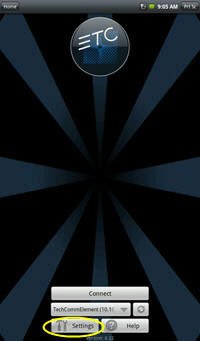
- Click {Consoles}.
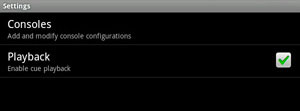
- Enter in the console's device name. Hit the [Back] button on your phone to exit to the next field.
- Enter in the console's IP address. Hit the [Back] button on your phone to exit to the next field.
- Enter in the password. For Eos Family consoles, this will be the console's device name. For Congo consoles, it isn't needed so you can leave it blank.
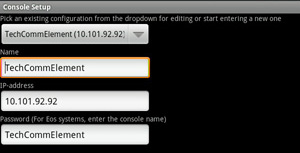
- Hit {Save} and hit the [Back] button twice to return to the welcome screen.
- From the welcome screen, select your console from the dropdown menu. If the aRFR app doesn't see your console online, it will display offline next to the console's name in the dropdown menu. If you know that the console is online, you can press the Refresh button to force a refresh of the status.
- Press the {Connect} button
Using the Virtual RFR
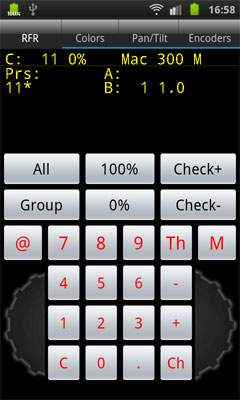
The Virtual RFR is designed to work exactly as the actual Net3TM RFR. Please refer to the RFR section in your console's manual for instructions on general RFR use.
You can download your console's manual here:
http://www.etcconnect.com/products.controls.aspx
There is one special command that you should know about. Since it isn't possible to hold C and CH down at the same time (as you can on the physical RFR), holding C down for a short while will clear the channel selection.
Using the Displays
In addition to the virtual RFR display, the aRFR has three additional displays: {Colors}, {Pan/Tilt}, {Encoders}.
- {Colors} - is a color picker display.
- {Pan/Tilt} - is a pan and tilt display.
- {Encoders} - displays the available encoders for a fixture.
At the top of three of the displays ({Colors}, {Pan/Tilt}, and {Encoders}), there are three white buttons. The two on the sides are for paging through the channels and the center one displays the currently selected channel. If you click on the center button, you will open a numerical keypad to be able to type in a channel number.

Using the Color Picker
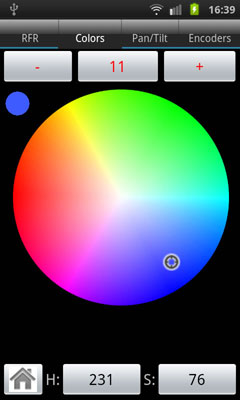
The current color for the first selected channel will be indicated by a small rotating cursor and in a small preview window to the left of the color wheel. Press anywhere on the color wheel to change the color, and the cursor will move to the new color.
Press the Home button to home the color.
To enter a specific value, you can click on the H or S buttons. This will open a small dialog where you can type in a parameter value.
Using the Pan/Tilt display
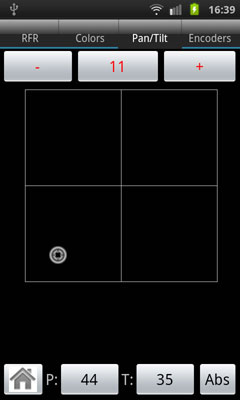
The current Pan/Tilt values for the selected channel are displayed by the crosshair cursor on the graph. To change the Pan/Tilt values, click on the graph. Press the Home button to home Pan and Tilt.
To enter a specific value, you can click on the P or T buttons. This will open a small dialog where you can type in a parameter value.
Pan/Tilt has three different modes, Absolute, Fine, and Coarse. Click on the button in the bottom right corner to toggle between these modes. In Absolute mode, the Pan/Tilt values will snap to the location that you touched on the graph. In fine & coarse modes, you will need to drag your finger slowly to adjust the values
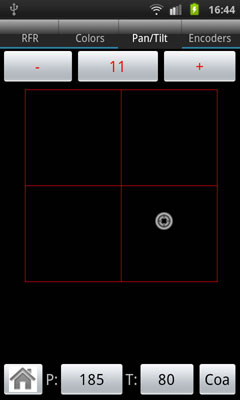
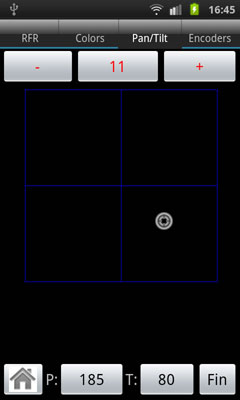
Using the Encoder Display

If the selected channel has related parameters, they will be shown on this display. If there are more parameters than what will fit, use the << and >> buttons to shift between multiple parameter pages. Current Congo software is limited to supporting Pan, Tilt and Hue/Sat controls.
Each parameter has a vertical section with the following items:
- Parameter name
- Parameter value
- Parameter encoder area where you control the parameter value by moving your finger
- Home button that takes the parameter to its programmed home position
